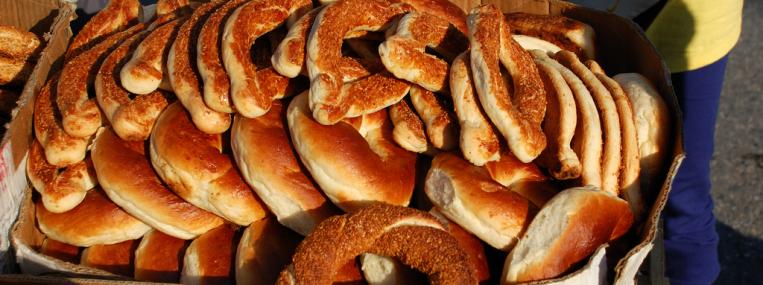
Turkey’s Soul Food
Simit, the street food standby, is under threat.

Simit, the street food standby, is under threat.
Whether they enjoy it at breakfast, lunch, dinner, or snack time, Turks have a weakness for the simit. At all hours of the day, Istanbul residents can buy the bagel-shaped bread, served with a slather of mild cheese, from vendors with street carts, tray-toting men on foot, even Starbucks baristas. The state-mandated price: one Turkish lira (roughly 55 cents).
But these days Turks hunger for more than their daily bread, says Alisa Roth, a writer based in New York City, in Gastronomica. The Turkish economy is off and running, foreign companies have arrived with exotic new foods, and Turkey dreams of recapturing the greatness of the Ottoman Empire. The country’s traditional simit sellers (simitçi) and simit makers (simit-ustasi) are left to fret: Will all the progress spoil Turks’ appetite for an old staple?
Though the simit’s geographic origins are unclear—possible birthplaces include Central Asia and Armenia—Turks have enjoyed the national bread for hundreds of years. Ottoman royals developed a taste for it in the 16th or 18th century. It subsequently conquered the empire, possibly reaching as far as Eastern Europe, where some say the simit gave birth to the bagel.
Every morning at Turkish mom-and-pop bakeries, bakers knead four simple ingredients into dough: yeast, water, salt, and flour. They work the dough into thin ropes, tie them into rings, and dip them in a mulberry syrup called dut pekmez, which is what gives simits their savory flavor. The bakers roll them through sesame seeds, shape them into circles, and bake them in huge brick ovens. Then they’re shipped off to cafés, hotels, and countless street vendors. “Simits are the meat of the poor,” an Istanbul restaurant owner named Musa Dağdeviren explained to Roth. It’s a point not lost on Turkish prime minister Recep Tayyip Erdogan. In his 2002 election campaign, he burnished his image as a man of the people by recalling his boyhood experiences selling simits in Istanbul’s streets.
But the traditional simit is increasingly under attack. Motivated in part by its desire to join the European Union, the government has decreed that all food sold on the street must be vended from carts with closed glass cases. That would deprive the simits of the crispiness that is essential to their appeal. Fortunately, enforcement has been lax.
The bigger threat may be competition. Turkish palates are being seduced by newcomers such as pizza and Big Macs. And then there is Simit Sarayı (Simit Palace). Founded in 2002 by Haluk Okutur, a Turkish tycoon, the chain has rapidly become the Turkish version of Dunkin’ Donuts, with simits—80 million a year—as their centerpiece. Okutur has opened more than 200 stores, including branches in Germany and Saudi Arabia.
Okutur claims that he rescued simits from oblivion. “We have revived a traditional food which was disappearing,” he told Roth. “Simit sales were going down, more hygienic production was needed.”
Traditional simit baking is hard, low-prestige work that is losing its appeal as Turkey modernizes. Nearly all of Istanbul’s bakers are migrants from Tokat, a provincial city to the east. Aydın Eryılmaz, a second-generation baker who runs Tophane Simitçisi with his brother, wants his two daughters to “get educated so they can do something else.”
Prosperity has also yielded artisanal bakers. Mehmet Özdemir sells his simits to artists and others who appreciate “organic” ingredients. “These businessmen who entered the simit business said, ‘Oh, I can make simit a brand,’” he told Roth. “[But] it’s not business, it’s culture.”
Roth doesn’t venture any predictions about the simit’s struggle at home, but she sees a wealth of possibilities abroad. “Turkey has been trying to reclaim its Ottoman role as a global political and economic leader,” she concludes. “Maybe the simit will be the ambassador it needs.”
THE SOURCE: “Simit: Turkey’s National Bread” by Alisa Roth, in Gastronomica, Winter 2012.